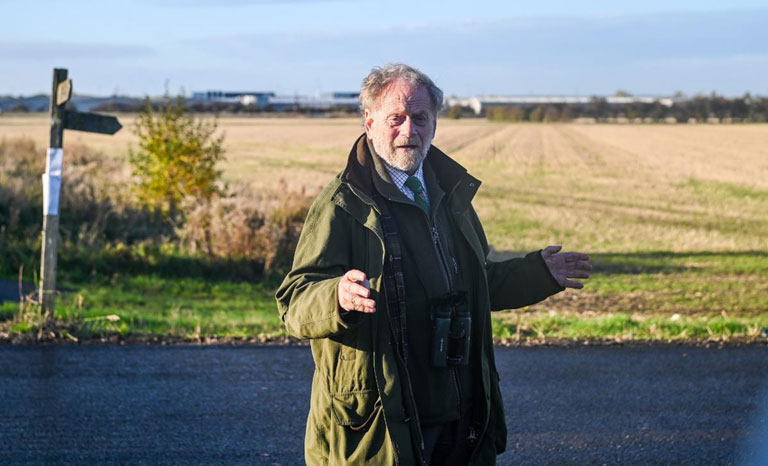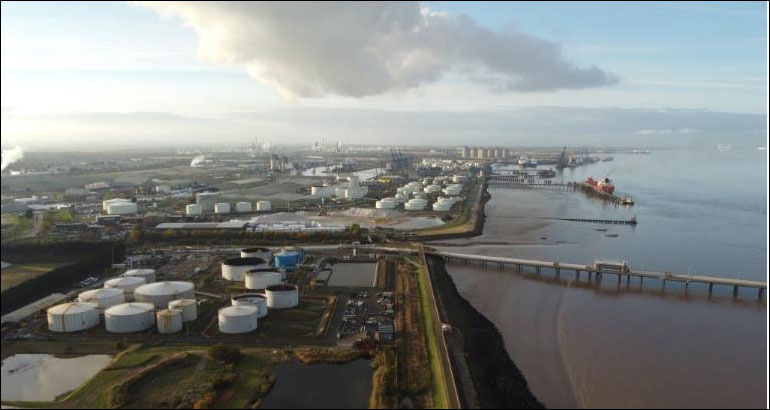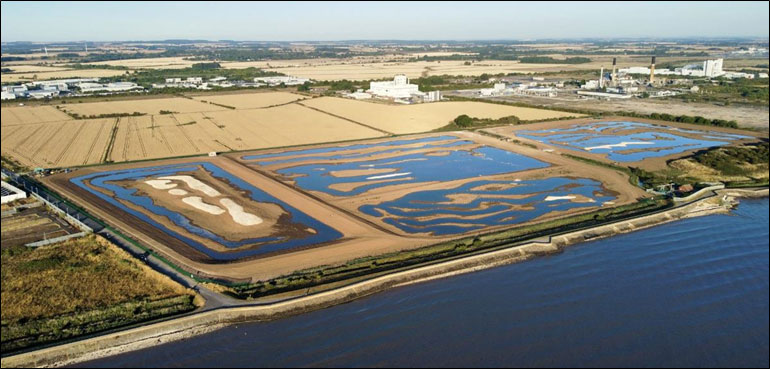Work is now complete on the creation of a new wetland habitat on 35 acres of land adjacent to the Novartis factory on the outskirts of Grimsby. Located adjacent to the Humber Estuary, it will be managed by North East Lincolnshire Council, Here, Liz Marsden, of NELC, discusses the project with ROGER WARDLE (pictured below) who designed it.
Novartis Ings site is the second significant wildlife haven built in North East Lincolnshire. The first, the nearby Cress Marsh, was created in 2018 and has already attracted a good range of wildlife including the return of breeding wader species such as Avocets and Little Ringed Plovers.
Novartis Ings is ideally located directly adjacent to the Humber Estuary. It has been created following the transfer of 35 acres of land, free of charge, from the pharmaceutical giant, Novartis Grimsby. They left this as their legacy to the local community after manufacturing at the site next door for over 70 years. This is boosted by another parcel of land formerly owned by Solenis, in total around 18 hectares or the equivalent of 20 football fields.

Photograph: Roger Wardle on site Oct 2022
Why is this being done?
In years to come, much of the hinterland of the Humber estuary will attract economic industrial and other developments.
Both Novartis Ings and Cress Marsh have been created as part of the £42m South Humber Industrial Investment Programme that has already seen the creation of the new link road between Grimsby and Immingham, and a purpose-built business park on the A1173 near Immingham.
As a condition of development, mitigation land must be set aside especially for roosting waders. These birds require wide open undisturbed sites ideally with a mosaic of shallow water with spits and island where they can roost safely at high tide.

Immingham Dock Complex from North Beck Drain (looking west) © Andrew P. Chick 2021
The council has taken the innovative approach of building the mitigation sites before they are actually needed.
These mitigation sites are creating specially designed and protected areas for waders close to their feeding grounds, but must be free from disturbance.
The close proximity of the site and short flight saves the birds’ precious energy. This is particularly important when birds are stressed by bad weather, recuperating from a long migration flight or building up condition ready for migration and breeding in spring.
The birds’ behaviour is driven by the tides, feeding when the invertebrate rich mudflats are exposed, usually twice a day, but then birds are displaced as the water returns. The waders fly over the sea defence to find somewhere to roost and rest in relative safety until the tide once again goes out.
Just like humans, birds prefer to take the easy option, travelling the least convenient distance. This also conserves energy that also helps with survival and ability to migrate and breed. This is why we think this site, right on the edge of the Humber, will be a success.
What does the site look like?
The site will be providing wet grassland that is in mosaic with a storage lagoon, scrapes, islands and spits with slightly higher points to help the birds spot potential predators. Appearance to some will be a rather open and bare habitat but that is just what the wader’s need and are adapted to as a means of reducing predation.
It is a low rainfall area and very well drained with modern mostly artificially pumped systems. This poses a problem that is addressed by removing or blocking up the onsite drainage to help raise the water table, but without impacting neighbours.
Extensive excavations are also undertaken to transform the virtually flat land into one with undulations where the low areas form shallow surface water habitats. The water also surrounding a variety of island like features that helps protect the waders from ground predation.
Additional water is required because precipitation alone is inadequate. This will be harvested from the Mawmbridge Drain just before it would otherwise be discharged into the Estuary, with no additional demand on the local water supply system. Some of that water will be stored in the lagoon and released in dry times to increase the habitat’s resilience to drought.
What birds are likely to use the site?
The primary design of the site aims to provide a reliable wader roosting area free of disturbance with essential short vegetation within a wide-open habitat to which they are adapted.
Oystercatcher, Lapwing, Redshank and other waders used to breed in the area but are now very scarce or do not breed at all locally due to a lack of suitable breeding habitat.

Lapwing © Neil Smith 2019
This new site, although primarily designed for roosting, is likely to provide renewed opportunities for lost breeding waders to return.
Look out for the iconic Lapwing and their easily seen breeding displays that usually start in February. That is followed by a quieter period whilst vulnerable eggs are being incubated to hatch towards the end of April, when the birds fearlessly defend against predators by mobbing them.
As the habitat develops it is hoped that other species will also breed such as ring plover and even possibly terns if the numbers of gulls is not too high.
Some islands, especially in the lagoon, have gravel and shell toppings that benefit wader roosting by simulating natural features associated with the estuary but are also good for breeding waders and other potential species.
Pyewipe Estate just down the road takes the local name for the Lapwing indicating that in the past they were common in the area.
We will also be introducing cattle to the site from spring to autumn to help control the vegetation - the target species for this site much preferring short grass or bare ground.
The cattle also make large footprints at the water’s edge creating micro-habitats for lots of insects that the birds subsequently feed on, not to mention the large biomass of invertebrates that live on dung pats.

Novartis Ings Summer 2022
How to watch the birds
Autumn, winter and early spring, especially when the tide is in, should see significant flocks flying in and out of the site, but easily overlooked once landed. They will be easily visible from the edges and the sea wall, better still with binoculars. As with all sites like this, we would ask that people respect the site, keep quiet and generally try to reduce bird disturbance.
Waders can be fickle creatures, and flocks are especially vulnerable to disturbance. Once the most nervous bird takes flight it panics them all. The tall green fencing around the site, in part helps to break up the shape of people and pets.
We have laid things out primarily to meet the birds’ needs otherwise they will not benefit from the site. However, there is also good observation from the boundary or sea wall.
Final thoughts?
Only time will tell - it might not be an overnight success, but we are very optimistic the site will make a significant environmental contribution in conserving the waders of the Humber.









